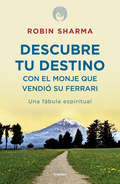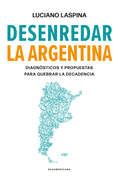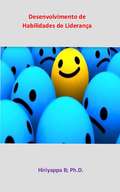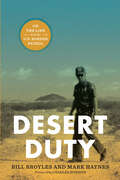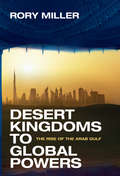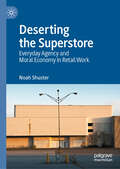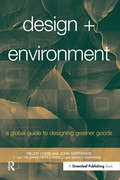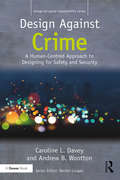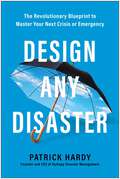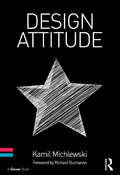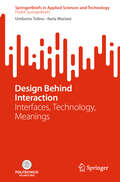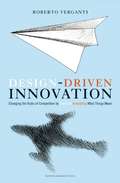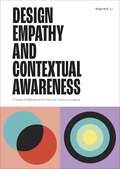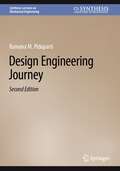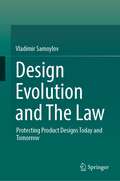- Table View
- List View
Descubre tu destino con el monje que vendió su Ferrari: Una fábula espiritual
by Robin Sharma¡Aprende cómo conseguir la vida que siempre has soñado tener y transforma definitivamente todas las dimensiones de tu mundo! Éste es el último libro de la serie que protagoniza el famoso monje que vendió su Ferrari, una obra que puede conseguir que mires el mundo con otros ojos. Te enseñará a despertar tu yo más íntimo y te ayudará a lograr una vida más plena y más feliz, así como prosperidad y paz interior. Lo único que tienes que hacer es mirar dentro de ti. Escrito como una fábula, Descubre tu destino con el monje que vendió su Ferrari ofrece nuevos aspectos de la sabiduría de Julian Mantle, el superabogado que cambió su vida de lujo por la paz interior y la felicidad. Una ficción inolvidable y paradójicamente realista, que desvela el verdadero propósito de la vida y muestra cómo liberar todo el potencial del ser, el secreto de la felicidad y la importancia de desbordar los límites para así encontrar el camino de la libertad personal. Una combinación de profundidad y lecciones prácticas que abrirá las puertas de las infinitas posibilidades que la vida depara a todas las personas y que transformarán definitivamente todas las dimensiones de tu mundo. Que te enseñará cómo conseguir la vida que siempre has soñado tener.
Descubre tu marca - Hazlo tú mismo: Un manual de Branding para autores
by Alma Edith Garcia Emlyn ChandDescubre tu marca y cómo comunicarla a los lectores con consejos comprobados que puedes poner en marcha hoy mismo. ¿Te está costando trabajo condensar todo lo que representa tu escritura en un paquete limpio, ordenado y que esté explicado fácilmente? Quizá todavía estés tratando de averiguar qué significa cuando una marca aplica a una persona. O tal vez ya has diluido tanto tu marca que los lectores no tienen idea de qué esperar cuando ven uno de tus libros. ¡Descubre tu marca está aquí para ayudarte! En tan sólo unas horas puedes descubrir un camino completamente nuevo para tu escritura o darle más certeza a tu camino existente. Aprenderás cómo son y cómo piensan tus lectores ideales y cómo hacer que se emocionen. Con esta guía podrás: Participar en un ejercicio guiado de branding Hacer una lluvia de ideas y tomar prestadas ocho Ponerle cara a tu lector ideal Determinar si necesitas un seudónimo Aprender cuáles son las reglas de escritura y comercialización que pueden romperse de vez en cuando Encontrar tu género (¡al estilo de "elige tu propia aventura"!) Definir tu marca en tres palabras Crear una biografía y un lema de autor Establecer un plan para tus intereses y habilidades en evolución Descargar cinco regalos exclusivos para los lectores de este libro Nuestra garantía: ¿Estás cansado de examinar meticulosamente las guías de marketing que se centran más en la experiencia de vida del autor que en consejos que puedas aplicar a tu carrera? ¿O peor aún, de las guías de consejos que en realidad son para autores de no ficción y tienen muy poca información valiosa para novelistas? ¿Qué pasa cuando un libro entero parece ser una mera presentación de los servicios del autor o de otros libros de su serie? Nosotros también estamos hartos de eso. Cada guía de Novel Publicity para escribir y comercializar la ficción se centra en ti. Si eres es un aspirante a novel
Desenredar la Argentina: Diagnósticos y propuestas para quebrar la decadencia
by Luciano LaspinaUna salida a las profundas heridas generadas por el populismo a través de medidas para no repetir los errores que llevaron a la actual decadencia. Diagnóstico de los principales problemas que enfrentará el próximo gobierno y reformas económicas orientadas a resolverlos. «El próximo gobierno asumirá en medio de la crisis terminal de un nuevo experimento populista en la Argentina. Nuestro país tiene una larguísima tradición de populismo político y macroeconómico. La economía argentina está totalmente enredada. Enredada en una maraña de complejas regulaciones, altos impuestos, trabas para importar, impuestos para exportar, insólitas restricciones y costos para crear empleos, desincentivos e inseguridad jurídica para invertir, dificultades crónicas para ahorrar sin ser estafado por la inflación e imposibilidad de obtener créditos a plazos y tasas razonables. Por eso, la economía tropieza con crisis y recesiones desde hace muchas décadas. El próximo gobierno deberá desenredar rápidamente la Argentina impulsando reformas valientes». Con firme decisión política y sólida argumentación técnica, Luciano Laspina propone Desenredar la Argentina marcando la salida de las profundas heridas generadas por el populismo, y presentando medidas para no repetir los errores que llevaron a la actual decadencia. Cada capítulo de esta obra elabora el diagnóstico de los principales problemas que enfrentará el próximo gobierno y expone las reformas económicas orientadas a resolverlos. El mensaje del libro es esperanzador: si al capital humano y los recursos naturales de nuestra tierra sumamos la determinación política de dejar atrás las recetas del pasado y avanzar hacia el desarrollo, lograremos el país grande y respetado que ansiamos.
Desenvolvimento da Personalidade e as suas Teorias
by Hiriyappa B António CorreiaEste livro ajuda uma pessoa a ganhar autoconfiança, a melhorar a autoestima, automotivação, automonitorização, autoavaliação e autocontrolo, e encontra as várias fases do ciclo de vida da pessoa.
Desenvolvimento de Habilidades de Liderança
by Pietro Fernandes de Faria Hiriyappa BO texto coloca estudantes no desenvolvimento de habilidades de liderança e aplicando efetivamente a capacidade de lidar com funções de liderança no trabalho e na vida. Esse texto dá aos aprendizes um mapa claro através do desenvolvimento de habilidades de liderança e a ver onde eles estão atualmente para formar planos para desenvolver melhores habilidades de liderança. Esse livro apresenta desenvolvimento efetivo de habilidades de liderança e ajuda você a melhorar suas habilidades e aponta o que você precisa fazer para se tornar um líder.
Desert Duty: On the Line with the U.S. Border Patrol
by Bill Broyles Mark HaynesWhile politicians and pundits endlessly debate immigration policy, U. S. Border Patrol agents put their lives on the line to enforce immigration law. In a day's work, agents may catch a load of narcotics, apprehend groups of people entering the country illegally, and intercept a potential terrorist. Their days often include rescuing aliens from death by thirst or murder by border bandits, preventing neighborhood assaults and burglaries, and administering first aid to accident victims, and may involve delivering an untimely baby or helping stranded motorists. As Bill Broyles and Mark Haynes sum it up, "Border Patrol is a hero job," one that too often goes unrecognized by the public. Desert Duty puts a human face on the Border Patrol. It features interviews with nineteen active-duty and retired agents who have worked at the Wellton, Arizona, station that watches over what is arguably the most perilous crossing along the border-a sparsely populated region of the Sonoran Desert with little water and summer temperatures that routinely top 110°F. The agents candidly discuss the rewards and frustrations of holding the line against illegal immigrants, smugglers, and other criminals-while often having to help the very people they are trying to thwart when they get into trouble in the desert. As one agent explains, "The thrill is tracking 'em up before they die. It's a rough ol' way to go-run outta water in this desert. "
Desert Edens: Colonial Climate Engineering in the Age of Anxiety (Histories of Economic Life #9)
by Philipp LehmannHow technological advances and colonial fears inspired utopian geoengineering projects during the late nineteenth and early twentieth centuries From the 1870s to the mid-twentieth century, European explorers, climatologists, colonial officials, and planners were avidly interested in large-scale projects that might actively alter the climate. Uncovering this history, Desert Edens looks at how arid environments and an increasing anxiety about climate in the colonial world shaped this upsurge in ideas about climate engineering. From notions about the transformation of deserts into forests to Nazi plans to influence the climates of war-torn areas, Philipp Lehmann puts the early climate change debate in its environmental, intellectual, and political context, and considers the ways this legacy reverberates in the present climate crisis.Lehmann examines some of the most ambitious climate-engineering projects to emerge in the late nineteenth and early twentieth centuries. Confronted with the Sahara in the 1870s, the French developed concepts for a flooding project that would lead to the creation of a man-made Sahara Sea. In the 1920s, German architect Herman Sörgel proposed damming the Mediterranean in order to geoengineer an Afro-European continent called &“Atlantropa,&” which would fit the needs of European settlers. Nazi designs were formulated to counteract the desertification of Eastern Europe and Central Asia. Despite ideological and technical differences, these projects all incorporated and developed climate change theories and vocabulary. They also combined expressions of an extreme environmental pessimism with a powerful technological optimism that continue to shape the contemporary moment.Focusing on the intellectual roots, intended effects, and impact of early measures to modify the climate, Desert Edens investigates how the technological imagination can be inspired by pressing fears about the environment and civilization.
Desert Kingdoms to Global Powers: The Rise of the Arab Gulf
by Rory MillerAn expert in Arab Gulf politics offers a revealing analysis of the region&’s stunning rise to global power and the challenges it confronts today. Once just sleepy desert sheikdoms, the Arab Gulf states of Saudi Arabia, Oman, the United Arab Emirates, Qatar, Bahrain, and Kuwait now exert unprecedented influence on international affairs—the result of their almost unimaginable riches in oil and gas. In this accessible study, Gulf politics expert Rory Miller examines the achievements of these countries since the 1973 global oil crisis. He also investigates how the shrewd Arab Gulf rulers who have overcome crisis after crisis meet the unpredictable future. The Arab Gulf region has become a global hub for travel, tourism, sports, culture, trade, and finance. But can the autocratic regimes maintain stability at home and influence abroad as they deal with the demands of social and democratic reform? Miller considers an array of factors—Islamism, terrorism, the Arab Spring, volatile oil prices, global power dynamics, and others—to assess the region&’s future possibilities.
Deserting the Superstore: Everyday Agency and Moral Economy in Retail Work
by Noah ShusterCorporate retail chains, like Walmart and Target, are the largest employers of working-class Americans. And yet, this class of workers is rarely examined as political agents, in contrast to union workers or government employees. What is often presumed about retail workers—that they steal from their employers, are frequently absent for shifts, and present lazy attitudes—is seen as reflective of the personal character of these workers. In Deserting the Superstore, Noah Shuster explores the political agency and power of corporate retail chains employees. He argues these employees are politically aware and politically active but tend to direct their efforts towards disobedience and desertion rather than reform. Through over two dozen interviews, Shuster presents narratives of corporate retail employees experiences of their work and how they take action to attain and preserve dignity in the workplace. This study finds retail workers articulating values that are contrary to capitalist ideology and that encouragingly point towards the possibility of a post-capitalist future among the U.S.'s post-industrial working class.
Deserved: Economic Memories After the Fall of the Iron Curtain
by Till HilmarAfter the fall of the Iron Curtain, people across the former socialist world saw their lives transformed. In just a few years, labor markets were completely disrupted, and the meanings attached to work were drastically altered. How did people who found themselves living under state socialism one day and capitalist democracy the next adjust to the changing social order and its new system of values?Till Hilmar examines memories of the postsocialist transition in East Germany and the Czech Republic to offer new insights into the power of narratives about economic change. Despite the structural nature of economic shifts, people often interpret life outcomes in individual terms. Many are deeply attached to the belief that success and failure must be deserved. Emphasizing individual effort, responsibility, and character, they pass moral judgments based on a person’s fortunes in the job market. Hilmar argues that such frameworks represent ways of making sense of the profound economic and social dislocations after 1989. People craft narratives of deservingness about themselves and others to solve the problem of belonging in a new social order.Drawing on in-depth interviews with engineers and care workers as well as historical and comparative analysis of the breakdown of communism in Eastern Europe, Deserved sheds new light on the moral imagination of capitalism and the experience of economic change. This book also offers crucial perspective on present-day politics, showing how notions of deservingness and moral worth have propelled right-wing populism.
Design + Environment: A Global Guide to Designing Greener Goods
by Helen Lewis Tim Grant John Gertsakis Nicola Morelli Andrew SweatmanThere is a huge scarcity of good, practical resources for designers and students interested in minimizing the environmental impacts of products. Design + Environment has been specifically written to address this paucity. The book first provides background information to help the reader understand how and why design for environment (DfE) has become so critical to design, with reference to some of the most influential writers, designers and companies in the field. Next, Design + Environment provides a step-by-step approach on how to approach DfE: to design a product that meets requirements for quality, cost, manufacturability and consumer appeal, while at the same time minimising environmental impacts. The first step in the process is to undertake an assessment of environmental impacts, using life-cycle assessment (LCA) or one of the many simpler tools available to help the designer. From then on, DfE becomes an integral part of the normal design process, including the development of concepts, design of prototypes, final design and development of marketing strategies. Environmental assessment tools and strategies to reduce environmental impacts, such as the selection of appropriate materials, are then discussed. Next, some of the links between environmental problems, such as global warming, ozone depletion, water and air pollution and the everyday products we consume are considered. In order to design products with minimal environmental impact, we need to have a basic understanding of these impacts and the interactions between them. The four subsequent chapters provide more detailed strategies and case studies for particular product groups: packaging, textiles, furniture, and electrical and electronic products. Guidelines are provided for each of the critical stages of a product's life, from the selection of raw materials through to strategies for recovery and recycling. Finally, Design + Environment takes a look at some of the emerging trends in DfE that are offering us the opportunity to make a more significant reduction in environmental impacts. Both the development of more sustainable materials and technologies and the growing interest in leasing rather than selling products are examined. Design + Environment is organized as a workbook rather than an academic text. It should be read once, and then used as a key reference source. This clear and informative book will prove to be invaluable to practising designers, to course directors and their students in need of a core teaching and reference text and to all those interested in learning about the tools and trends influencing green product design. The authors have all been involved in an innovative demonstration programme called "EcoReDesign", which was developed by the Centre for Design at RMIT University with funding from the Australian government. The Centre successfully collaborated with Australian companies to improve the environmental performance of their products by following DfE principles.
Design Against Crime: A Human-Centred Approach to Designing for Safety and Security (Design for Social Responsibility)
by Caroline L. Davey Andrew B. WoottonDesign Against Crime will aid the design profession to meet the challenges presented by the competing needs and complex systems around crime and security. It proposes that designers should use their creative talents to develop innovative solutions to security problems that contribute to the ongoing fight against crime. The authors first explain the design against crime approach to security and security. They go on to provide practical advice on addressing crime and insecurity within the design process and offer practical examples of design being applied to security and safety. They also examine crime victimisation from a global perspective, highlighting the benefits worldwide of reducing opportunities for crime, including issues of national security, such as terrorism and natural disasters. A design-led, human-centred approach provides a way forward that is both aspirational and practical. The book is aimed primarily at design professionals, educators and students interested in safety and security, from all design disciplines, including product design, architecture, service design and communication design. The book should also be read by crime prevention experts, planners, local authorities, managers of urban environments and policymakers.
Design Any Disaster: The Revolutionary Blueprint to Master Your Next Crisis or Emergency
by Patrick HardyNever experience a disaster again—ever. Hurricanes, wildfires, mass shootings, and pandemics are a reality for 21st century families and small businesses. But here&’s the truth: Not one of these has to be a disaster. What determines whether an unexpected event becomes a disaster is you. In Design Any Disaster, certified emergency manager and master business continuity practitioner Patrick Hardy reveals to you the secrets of disaster preparedness that helped him build the largest and most successful small business and family disaster planning company in the world. He explains why: You should never, ever &“remain calm&” during a disaster. 99% of all disaster plans are a complete waste of time. Fancy disaster equipment and supplies actually leave you less prepared. Design Any Disaster is not a survival manual. It&’s a revolutionary approach to disaster preparedness, response, and recovery for families and small businesses that can be used whether you live in the middle of a big city, in a quiet suburban neighborhood, or in a rural county with more cows than people. Using the powerful C3 Method Hardy uses with his clients, from Fortune 500 CEOs to average families, you will discover how to get ready (plan effectively), react (focus without panicking), respond (protect yourself and your possessions), and recover (overcome swiftly). And in a revolutionary section you will not find in any other disaster book, Hardy also reveals how to reverse disaster, converting the experience into an opportunity to become wiser and happier. Control the disaster so that it doesn&’t control you—that&’s how you Design Any Disaster.
Design Attitude
by Kamil MichlewskiDesign Attitude is a book for those who want to scratch beneath the surface and explore the impact design and designers have in organisations. It offers an alternative view on the sources of success and competitive advantage of companies such as Apple, where design plays a leading role. It sheds light on the cultural dynamics within organisations, where professional designers have a significant presence and influence. At its heart, the book asks a question: what is the nature of designers’ contribution that is truly unique to them as professionals? To answer this deceptively simple question the author combines a multitude of hours of ethnographic study inside the design community; in-depth interviews with executives and designers from Apple, IDEO, Wolff Olins, Philips Design, and Nissan Design; and a follow-up quantitative study. Since the author comes from a management and not a design background, the book offers a different perspective to most publications in the area of Design Thinking. It is a mirror held up to the community, rather than a voice from within. Design Attitude makes the compelling argument that looking at the type of the culture designers produce, rather than the type of processes or products they create, is potentially a more fruitful way of profiling the impact of design in organisations. With design being recognised as an important strategic framework by companies, not-for-profit organisations, and governments alike, this book is a distinct and timely contribution to the debate.
Design Behind Interaction: Interfaces, Technology, Meanings (SpringerBriefs in Applied Sciences and Technology)
by Ilaria Mariani Umberto TolinoThis book investigates how digital transformation and technological innovations are challenging traditional design paradigms and redefining the conception of interfaces, suggesting a future where interfaces seamlessly integrate into or disappear within smart objects. Through the lens of Thingk, a university spin-off of the Politecnico di Milano, it addresses the practical application of theoretical design research in creating objects that, while analog in appearance, are technologically augmented, embracing a multidisciplinary approach that includes product design, communication, and interaction design. Covering an eight-year span of experimental design and analysis, it dives into how smart objects leverage context-awareness and situated meanings, engaging users from research and co-creation to validation. The significance of this book lies in its comprehensive analysis and insights into the design process behind such objects, underscoring the need for thorough examination of how semantic reconfigurations impact on affordances and agency. With a strong emphasis on a research-through-design approach and case studies, it bridges theoretical inquiry with practical applications, offering insights into the potentials of design-driven innovation in evolving user experiences.
Design Driven Innovation
by Roberto VergantiUntil now, the literature on innovation has focused either on radical innovation pushed by technology or incremental innovation pulled by the market. In Design-Driven Innovation: How to Compete by Radically Innovating the Meaning of Products, Roberto Verganti introduces a third strategy, a radical shift in perspective that introduces a bold new way of competing. Design-driven innovations do not come from the market; they create new markets. They don't push new technologies; they push new meanings.It's about having a vision, and taking that vision to your customers. Think of game-changers like Nintendo's Wii or Apple's iPod. They overturned our understanding of what a video game means and how we listen to music. Customers had not asked for these new meanings, but once they experienced them, it was love at first sight.But where does the vision come from? With fascinating examples from leading European and American companies, Verganti shows that for truly breakthrough products and services, we must look beyond customers and users to those he calls "interpreters" - the experts who deeply understand and shape the markets they work in.Design-Driven Innovation offers a provocative new view of innovation thinking and practice.
Design Economies and the Changing World Economy: Innovation, Production and Competitiveness (Routledge Studies in Human Geography)
by Grete Rusten John R. BrysonDesign is central to every service or good produced, sold and consumed. Manufacturing and service companies located in high cost locations increasingly find it difficult to compete with producers located in countries such as India and China. Companies in high-cost locations either have to shift production abroad or create competitive advantage through design, innovation, brand and the geographic distribution of tasks rather than price. Design Economies and the Changing World Economy provides the first comprehensive account of the relationship between innovation, design, corporate competitiveness and place. Design economies are explored through an analysis of corporate strategies, the relationship between product and designer, copying and imitation including nefarious learning, design and competitiveness, and design-centred regional policies. The design process plays a critical role in corporate competitiveness as it functions at the intersection between production and consumption and the interface between consumer behaviour and the development and design of products. This book focuses on firms, individuals, as well as national policy, drawing attention to the development of corporate and nation based design strategies that are intended to enhance competitive advantage. Increasingly products are designed in one location and made in another. This separation of design from the place of production highlights the continued development of the international division of labour as tasks are distributed in different places, but blended together to produce design-intensive branded products. This book provides a distinctive analysis of the ways in which companies located in developed market economies compete on the basis of design, brand and the geographic distribution of tasks. The text contains case studies of major manufacturing and service companies and will be of valuable interest to students and researchers interested in Geography, Economics and Planning.
Design Education Today: Technical Contexts, Programs and Best Practices
by Dirk Schaefer Claudia Eckert Graham CoatesThis book provides extensive information on the key technical design disciplines, education programs, international best practices and modes of delivery that are aimed at preparing a trans-disciplinary design workforce for the future. It also presents a comprehensive overview of the scope of, and state of the art in, design education. The book highlights signature design education programs from around the globe and across all levels, in both traditional and distance learning settings. Additionally, it discusses professional societies for designers and design educators, as well as the current standards for professional registration, and program accreditation. Reflecting recent advances and emerging trends, it offers a valuable handbook for design practitioners and managers, curriculum designers and program leaders alike. It will also be of interest to students and academics looking to develop a career related to the more technical aspects of design.
Design Effective Interventions: Mobilizing People to Tackle an Adaptive Challenge
by Alexander Grashow Marty Linsky Ronald HeifetzEffective interventions mobilize people to tackle an adaptive challenge. They may be designed to make progress at any point in the process: for example, to surface a difficult issue, quash a diversion, or move people forward through a difficult period. At whatever stage of the process you are intervening, this chapter provides a checklist, a series of practices that can make your interventions more effective. This chapter was originally published as chapter 9 of "The Practice of Adaptive Leadership: Tools and Tactics for Changing Your Organization and the World."
Design Empathy and Contextual Awareness: Frames of Reference for the 21st Century Creative
by Wayne K. LiOne of the biggest challenges facing designers across all fields is not simply in the design of the product or service itself, but rather how to arrive at a design solution that resonates with a target audience, that will have a higher than likely chance at market adoption, and that will avoid negatively impacting society or the environment. What are the skills that can be employed by a student or young professional creative early on that enable them to identify the issues at work and address them? By understanding design from human-centered perspectives - both from the customer's and the producer's point of view - innovative, resonant designs are possible.Design Empathy and Contextual Awareness demystifies the "fuzzy" front end of the design process, where research methods mix with business trends and marketing. The accessible, authoritative text presents design as neither merely a "trade" skill nor an exercise in personal creative vision, but rather the application of multiple mindsets and practices, built around a process of alternating points of view (or "frames"). As well as covering theory and process, this visually engaging book also provides real-life business examples and applicable templates to help designers hone their empathy and contextual awareness in order to more directly and efficiently achieve successful design outcomes.Chapters cover: Laying a foundation: design as a whole-brain activity Design behaviors: design as a whole-life activity Empathy: cognitive and emotional empathy, and compassionate concern Contextual awareness: cultivating your designer's sixth sense
Design Empathy and Contextual Awareness: Frames of Reference for the 21st Century Creative
by Wayne K. LiOne of the biggest challenges facing designers across all fields is not simply in the design of the product or service itself, but rather how to arrive at a design solution that resonates with a target audience, that will have a higher than likely chance at market adoption, and that will avoid negatively impacting society or the environment. What are the skills that can be employed by a student or young professional creative early on that enable them to identify the issues at work and address them? By understanding design from human-centered perspectives - both from the customer's and the producer's point of view - innovative, resonant designs are possible.Design Empathy and Contextual Awareness demystifies the "fuzzy" front end of the design process, where research methods mix with business trends and marketing. The accessible, authoritative text presents design as neither merely a "trade" skill nor an exercise in personal creative vision, but rather the application of multiple mindsets and practices, built around a process of alternating points of view (or "frames"). As well as covering theory and process, this visually engaging book also provides real-life business examples and applicable templates to help designers hone their empathy and contextual awareness in order to more directly and efficiently achieve successful design outcomes.Chapters cover: Laying a foundation: design as a whole-brain activity Design behaviors: design as a whole-life activity Empathy: cognitive and emotional empathy, and compassionate concern Contextual awareness: cultivating your designer's sixth sense
Design Engineering Journey (Synthesis Lectures on Mechanical Engineering)
by Ramana M. PidapartiThis book provides an introductory treatment of the design methodology. It introduces the principles of design, and discusses design tools and techniques from traditional and multidisciplinary perspectives and comprehensively explores the design engineering process. It presents a broad multidisciplinary perspective to design.Delivers Innovation, creativity, design thinking, collaboration, communication, problem solving, and technical skills are key skills for tackling today's complex design problems.
Design Evolution and The Law: Protecting Product Designs Today and Tomorrow
by Vladimir SamoylovThis book focuses on product design which is evolving conceptually and practically with advances in technology. Product design is no longer solely about product stylization and decoration, but rather about providing a holistic product experience for the consumer. Therefore, in the foreseeable future, product designs will increasingly communicate not only to our eyes, but to our other senses as well.This book examines the frameworks for the protection of product designs in New Zealand and Australia and evaluates the appropriateness of expanding legal mechanisms for the accommodation of product design evolution. The value of more holistic design protection is balanced against other important considerations such as the “right to repair".The book not only anticipates the extent to which product design will cater to senses other than visual, but also provides a novel framework (with reference to industry examples) for discerning originality in such work for the purposes of copyright. This book also makes suggestions for how designs can be protected from foreseeable infringement (analogous to copyright infringement of music and movies on file sharing networks) resulting from future advances in technologies such as 3D printing and virtual reality.
Design Experiments: Leadership with Creativity
by Stewart D. FriedmanIt takes courage to experiment and push for change to better meet the expectations of people who depend on you. In this chapter, you'll learn about the kinds of experiments that, if designed and implemented effectively, will help you secure four-way wins that benefit your work, your home, your community, and your-self.
